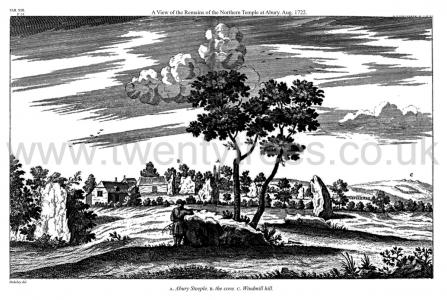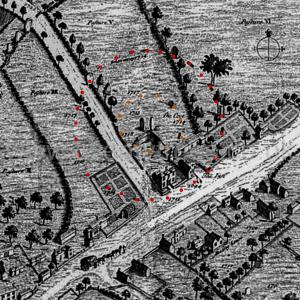Avebury Chapter V
Avebury Chapter V is in Avebury A Temple of British Druids, With Some Others, Described by William Stukeley.
Of the two great temples [Avebury South Circle and Avebury North Circle] included in the area of the great circle of stones. Each consists of two concentrick circles. One has a central obelisc or ambre, a very high stone in the center. The Egyptians called an obelisc an ambre. The other temple has a cove [Map] in the center, composed of three stones of a stupendous bulk, set in a nich-like figure. A short history of the destroyers of this noble work, but a very few years ago.
THE great circle of stones last described, together with the ditch and rampart inclosing all, may be esteemed as the præcinctus of the temple, not properly the temple; but including the area thereof. There are strictly within this great compass, two temples, of like form and dimensions: each temple consists of two concentric circles. The line that connects their centers, runs from north-west to south-east: which line passes thro' the center of the whole area. The outer circles of them consist each of 30 stones of like dimensions with those of the outer circle, and at like intervals. The inner circles of both consist each of 12 stones, of the same size and distances. The geometry therefore of them, when laid down on paper, shews, the inner circle must be 100 cubits in diameter, the outer 240.
The centers of these two double circles are 300 cubits asunder. Their circumferences or outward circles are 50 cubits asunder, in the nearest part. By which means they least embarrass each other, and leave the freest space about 'em, within the great circular portico (as we may call it) inclosing the whole; which we described in the former chapter. There is no other difference between these two temples (properly) which I could discover, save that one, the southermost, has a central obelisc, which was the kibla, whereto they turned their faces, in the religious offices there performed: the other has that immense work in the center, which the old Britons call a cove [Map]: consisting of three stones placed with an obtuse angle toward each other, and as it were, upon an ark of a circle, like the great half-round at the east end of some old cathedrals: or like the upper end of the cell at Stonehenge [Map]; being of the same use and intent, the adytum of this temple. This I have often times admired and been astonished at its extravagant magnitude and majesty. It stands in the yard belonging to the inn. King Charles II. in his progress this way, rode into the yard, on purpose to view it.
This cove of the northern temple was undoubtedly the kibla thereof. It opens pretty exactly north-east, as at Stonehenge. It measures 34 foot, from the edge of the outer jambs; 20 cubits: and half as much in depth. Varro V. divinorum, writes, altars were of old called ansæ. So Macrobius saturn. II. 11. It seems that they mean this figure before us. And I suppose 'tis what Schedius means; de dis germ. c. 25. speaking of altars among the old germans set in a triangle, he says, the Druids understood a mystery thereby. Perhaps they intended it for a nich-like hemispherical figure, in some sort to represent the heavens. Sex. Pompeius writes, the ancients called the heavens, cove. The altar properly lay upon the ground before this superb nich. That, no doubt, was carryed off long ago, as not being fixed in the earth, and one of the wings is gone too, the northern. It fell down 1713, as marked in the ground-plot.
Fit sonus ingenti concussa est pondere tellus. Virg.
[A sound was made, and the earth was shaken by a great weight. Vigil. The Aeneid Book 9 Line 752]
They told me it was full seven yards long, of the same shape as its opposite, tall and narrow. We measured this 17 foot above ground, 10 whole cubits; 7 foot broad, two and a half thick. These were the ansæ or wings of this noble ellipsis. That on the back, or in the middle, is much broader, being 15 foot, as many high, 4 thick; but a great piece of one side of it has been broke off by decay of the stone. We cannot conceive any thing bolder, than the idea of those people that entertained a design of setting up these stones. The vulgar call them the devil's brand-irons, from their extravagant bulk, and chimney-like form. These coves, as Maundrel says of the turkish kiblas, shew the Druids' aversion to idolatry, expressing the reality of the divine presence there, and at the same time its invisibility; no doubt a most ancient and oriental custom.
Of the exterior circle of this northern temple but three stones are now left standing, six more lying on the ground, one whereof in the street by the inn-gate. People yet alive remember several standing in the middle of the street; they were burnt for building, anno 1711. That at the corner of the lane, going to the north gate of the town, not many years since lying on the ground, was used as a stall to lay fish on, when they had a kind of market here. The ruin of the rest is noted in the ground-plot, and so of the others. But they told us, that about a dozen years ago both circles were standing, and almost entire. Those in the closes behind the inn, were taken up a year ago; (this was when I first went thither, about 1718,) farmer Green chiefly demolished them to build his house and walls at Bekamton. Of the southern temple several stones were destroyed by farmer John Fowler, twelve years ago; he owned to us that he burnt five of them; but fourteen are still left, whereof about half standing. Some lie along in the pastures, two let into the ground under a barn, others under the houses. One lies above ground under the corner of a house, over-against the inn. One buried under the earth in a little garden. The cavities left by some more are visible, in the places whereof ash-trees are set. All those in the pastures were standing within memory.
The central obelisk [Map] of this temple is of a circular form at base, of a vast bulk, 21 feet long, and 8 feet 9 inches diameter; when standing, higher than the rest. This is what the scripture calls a pillar, or standing image, Levit. xxvi. 1. These works, erected in the land of Canaan by the same people, the Phœnicians, as erected ours, were ordered to be demolished by the Israelites, because at that time perverted to idolatry. All the stones, our whole temple, were called ambres, even by our phœnician founders; but this particularly. The Egyptians by that name called their obeliscs; which Kircher did not rightly understand, interpreting it to be sacred books; but meaning petræ ambrosiæ, main ambres in celtic, anointed, consecrated stone; Manah, the name of a great stone of this sort which the Arabians worshipped. They were called likewise, gabal, and the present word kibla or kebla comes from it, but in a larger sense. Elagabalus is hence derived after they turned these kiblas into real deities. It means the god obe25lisc; and hence our english words, gable end of a house, javelin or roman pile, and gaveloc a sharp iron bar.
Table XIII. A View of the Remains of the Northern Temple at Abury. Aug. 1722. A. Abury Steeple. B. the cove [Map]. C. Windmill hill.

Exactly in the southern end of the line that connects the two centers of these temples, viz. in that pasture marked IX. in our ground-plot, is an odd stone standing [Map], not of great bulk. It has a hole wrought in it, and probably was designed to fasten the victim, in order for slaying it. This I call the ring-stone [Map]. From this we may infer the like use of that stone at Stonehenge, in the avenue near the entrance into the area of the temple. I spoke of it under the name of crwm leche, p. 33. It has a like hole in it.
These two temples were all that was standing originally in the great area, within the circular colonnade. Very probably it was the most magnificent patriarchal temple in the world. Now a whole village of about thirty houses is built within it. This area would hold an immense number of people at their panegyres and public festivals; and when the vallum all around was covered with spectators, it formed a most noble amphitheater, and had an appearance extremely august, during the administration of religious offices.
-ter denas curia vaccas
Accipit, & largo sparsa cruore madet. Ovid. fast. IV.
[thrice the cows of the court He takes it, and wets it with the blood that has been scattered widely? Ovid Fasti Book 4 Lines 635 and 636]
Each of these temples is four times as big as Stonehenge.
About 1694, Walter Stretch, father of one of the present inhabitants, found out the way of demolishing these stones by fire. He exercised this at first on one of the stones standing in the street before the inn, belonging to the outer circle of the southern temple. That one stone, containing 20 loads, built the dining-room end of the inn. Since then Tom Robinson, another Herostratus of the place, made cruel havock among them. He owned to us, that two of them cost eight pounds in the execution. Farmer Green ruined many of the southern temple to build his houses and walls at Bekamton. Since then many others have occasionally practised the sacrilegious method, and most of the houses, walls, and outhouses in the town are raised from these materials. Sir Robert Holford resented this destruction of them; and Reuben Horsall, parish-clerk, had a due veneration for these sacred remains, and assisted me in the best intelligence he was able to give. Concerning the purport of the disposition and manner of the temple hitherto described, I shall speak more largely in chap. X. toward the end, concluding this with an inscription of the Triopian farm consecrated by Herodes Atticus.
Ne cuiquam glebam, saxumve impune movere [Let no one move a clod or stone with impunity]
Ulli sit licitum. Parcarum namque severæ [Anyone is allowed. For the frugal and severe]
Pœnæ instant: siquis sacra scelus edat in æde. [Punishment is urgent: if the sacred crime eats in the food]
Finitimi agricolæ, & vicini attendite cuncti, [Neighbors, farmers, and neighbors were attentively gathered]
Hic fundus sacer est; immotaque jura deorum. [This ground is sacred; and the immovable law of the gods]
Avebury North Circle is 98m diameter Stone Circle. Only two of its stones are extant.
The North Circle may have been two circles, one within another, concentric, with the cove [Map] at its centre as shown on the Frontspiece to Stukeley's Chapter 5 where he has also shown the years in which the stones were destroyed ranging from 1694 to 1718. Stukeley's drawing shows and outer circle of twenty-eight stones and an inner circle of eleven stones.
